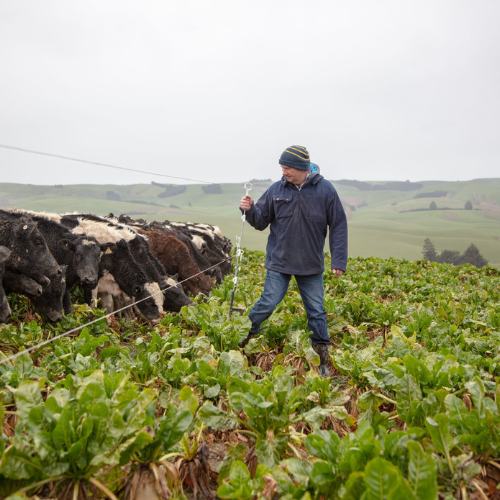Navigating winter grazing after challenging drought conditions
Thursday, 30 May, 2024

As winter approaches, Gallagher is offering dairy farmers in some parts of Taranaki and Manawatu advice about navigate winter grazing within tight feed budgets after a green drought has caused many to dip into winter supplements early. Gallagher Territory Manager for Taranaki, Whanganui, Martin Weir says some dairy farmers in his region have faced a challenging end to the season with areas south of Manawatu and in coastal and south Taranaki in a green drought that saw some farmers forced to dry off herds early and dip into supplements saved for winter.
A green drought is when there is just enough rain to keep the grass green, but not enough for it to grow and the soil is very dry.
There was only 25mm of rain recorded in the Manawatu in the last week of April and a Medium-Scale Adverse Event Classification was extended by the Government to Taranaki and Manawatu in March. The Government directive unlocks support for farmers that need it. Farmers and growers who need support can also contact their local Rural Support Trust on 0800 787 254.
“It’s been a challenging period for farmers and heading into winter maintaining cow health and condition on available pasture or crops and in tough weather conditions is critical,” says Martin. “It’s a balance of ensuring feed availability and maintaining cow health and condition within existing feed budgets.” Optimising grazing rounds and rotating pasture will be key to ensure a sustainable feed supply and to minimise the need for imported supplements, says Martin. “If they haven’t done it already farmers need a comprehensive feed budget tailored to their herd's requirements. They should be carefully monitoring pasture growth rates and only bring in supplement feed as necessary to meet nutritional needs,” says Martin.
He says using smart fencing solutions that keep herds where they need to be and effectively manage winter grazing are also key. “Farmers know all this, but it’s about doing the basics well. Regularly assess your pasture cover, ensure you have good fencing for break fencing crops and pasture and keep on top of cow health to identify any issues promptly.” Those wintering on crops should also keep up sustainable grazing practices to minimise any environmental impacts and promote long-term soil and pasture health.
Good fencing solutions can significantly enhance winter grazing management, says Martin. “Make sure you’re using portable fencing that is strong and stable to keep herds where you need them to be,” says Martin. Gallagher's smart fencing solutions can help allocate feed more precisely in these constrained times, says Martin. “Products like Gallagher’s Ring Top Posts provide superior strength and stability for break fences. With easy installation and adjustment capabilities they can help farmers manage changing pasture conditions,” says Martin.
Feedback from farmers is that they like Gallagher’s Ring Top Posts because they are sturdy and robust but also fully electrified, making them exceptionally effective at containing herds, he says. Using the ring top posts, coupled with Gallagher’s lithium energizer range, farmers can have peace of mind their herd is staying where it needs to be, says Martin.
MARTIN’S TOP WINTER BREAK-FENCING TIPS
- Use strong and stable portable fencing to keep herds where they need to be.
- Check out Gallagher’s Ring Top Posts, which provide superior strength and stability for break fences.
- Our ring top posts are easy to install and adjust, making them suitable for managing changing pasture conditions.
- They are also sturdy, robust, and fully electrified, making them exceptionally effective at containing herds.
- Use Gallagher’s lithium energizer range to ensure that the portable fencing is effective at keeping the herd safe and contained.
- Regularly assess and maintain fencing. Continuously check the condition of your fences and make necessary adjustments to ensure they remain effective.
- Ensure you have good fencing for break fencing crops and pasture to manage grazing effectively and keep herds in designated areas.